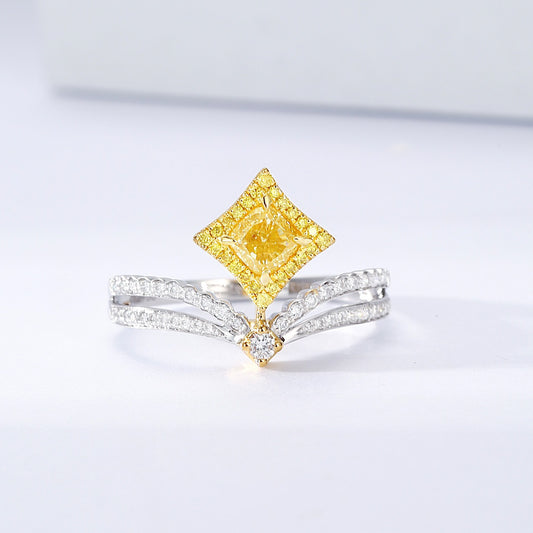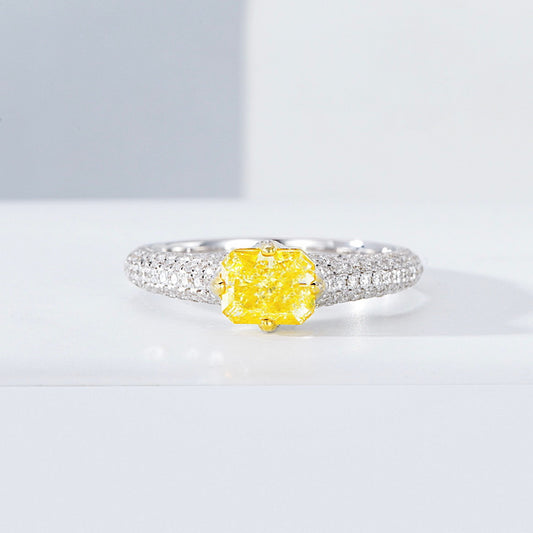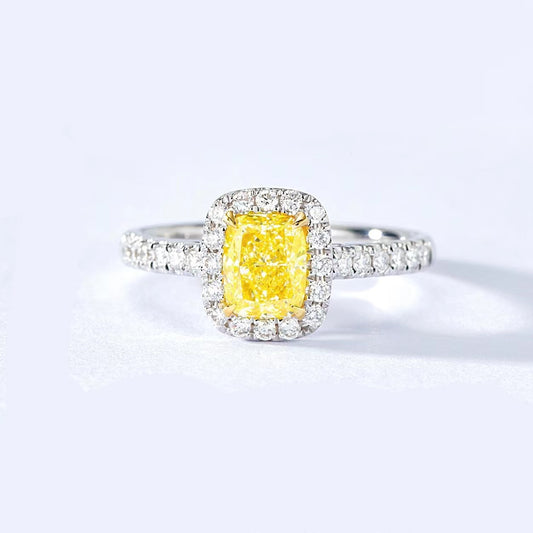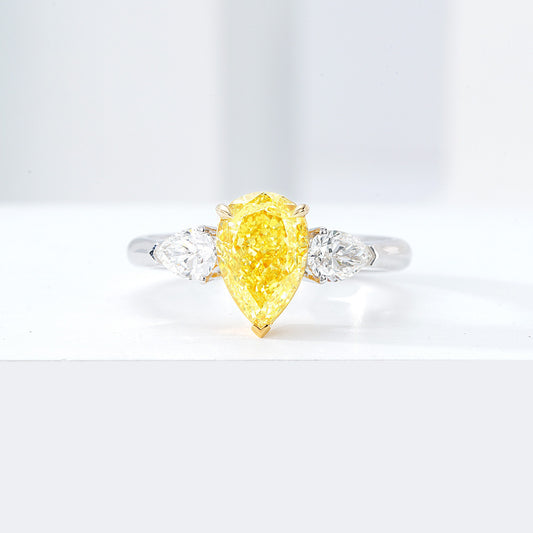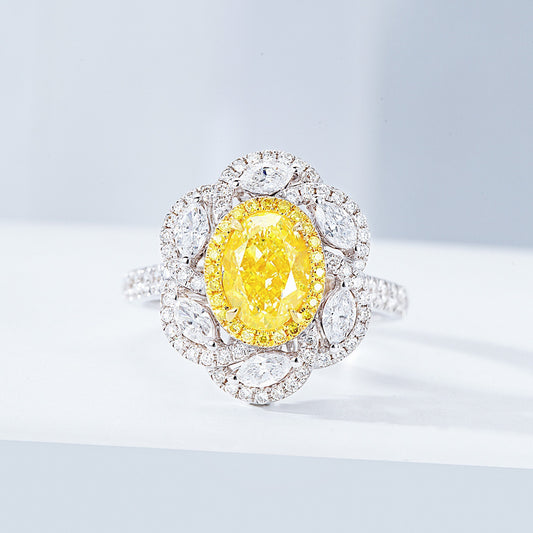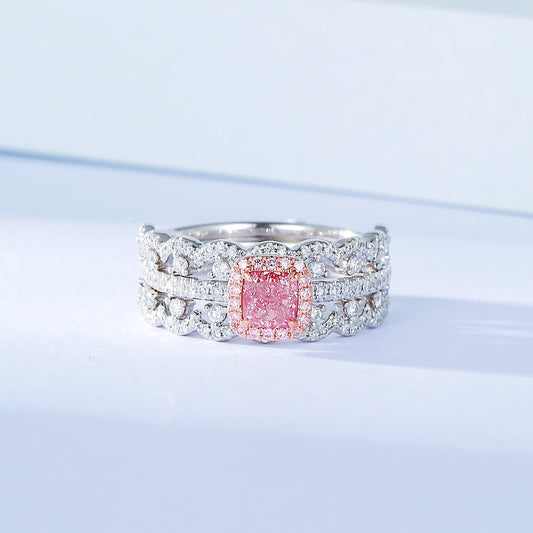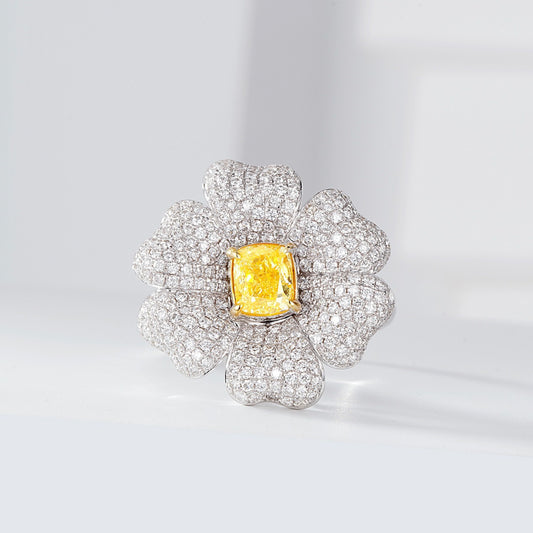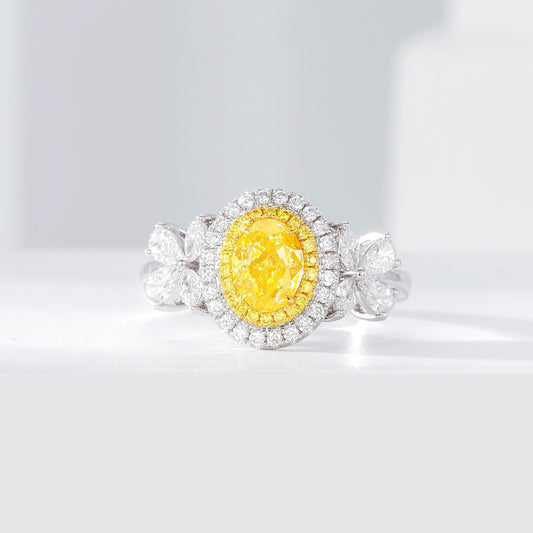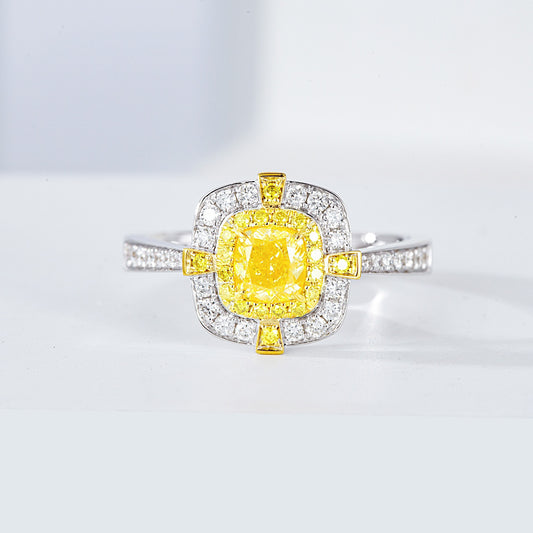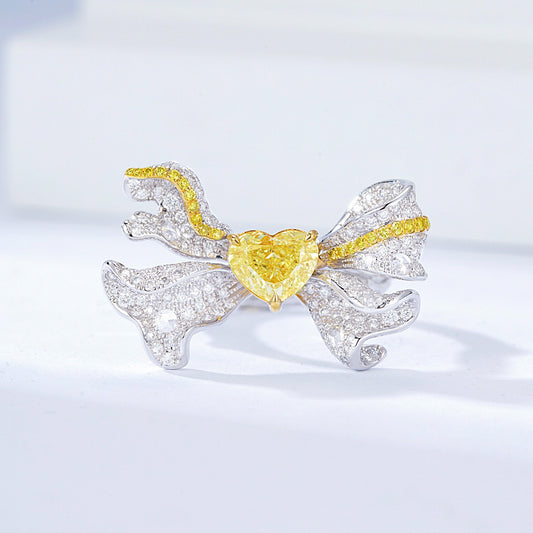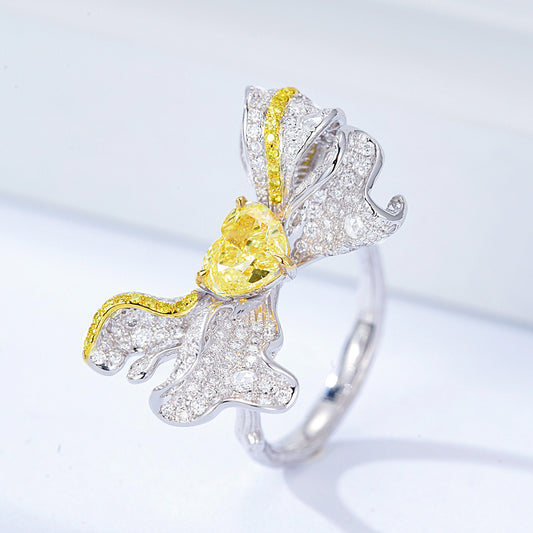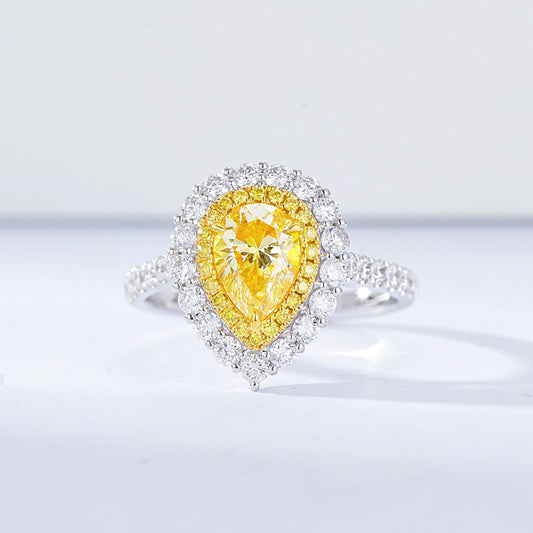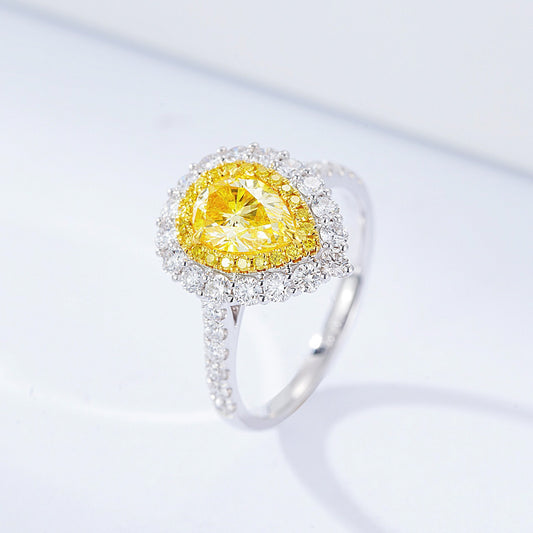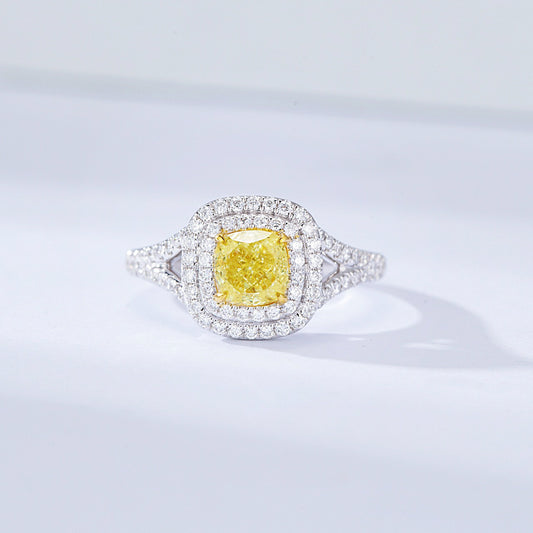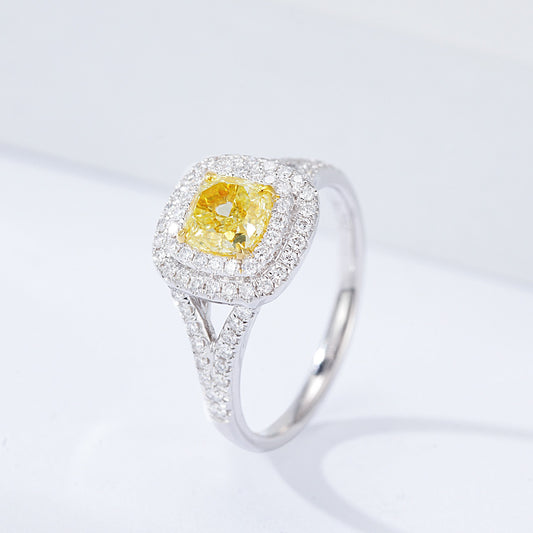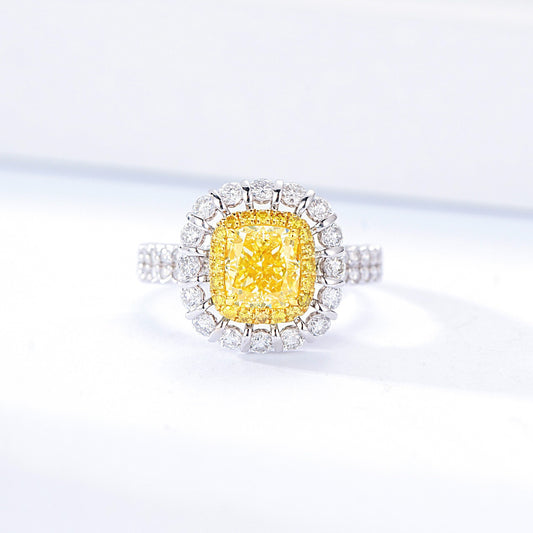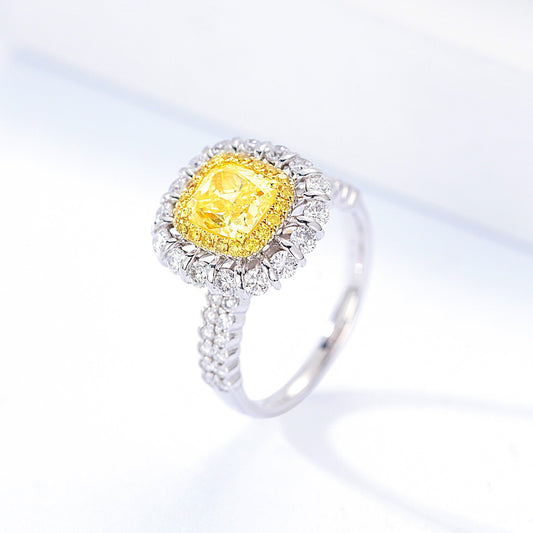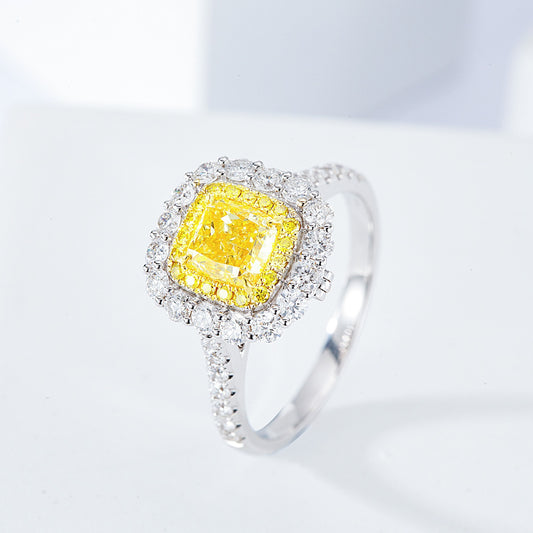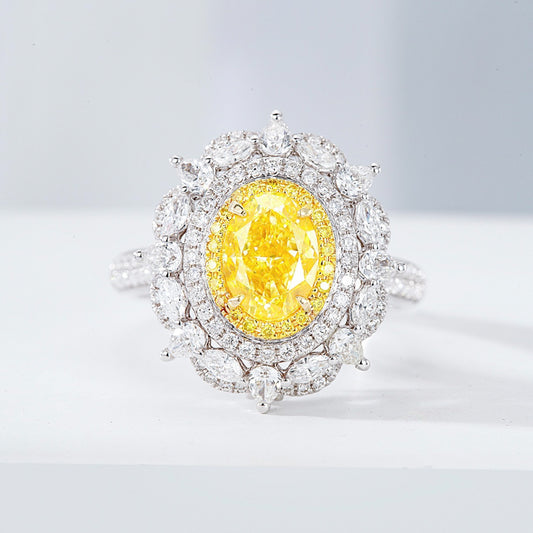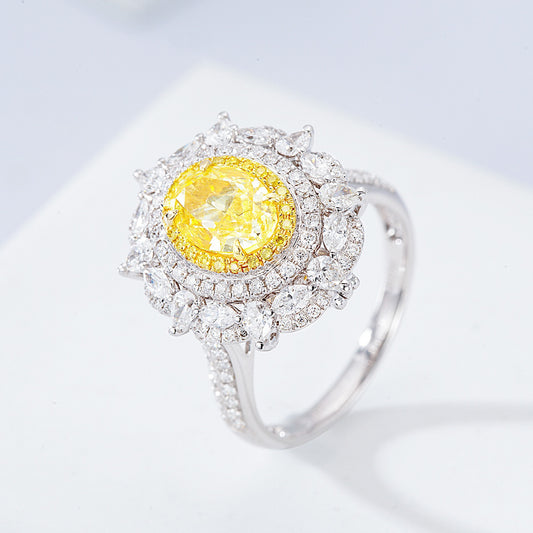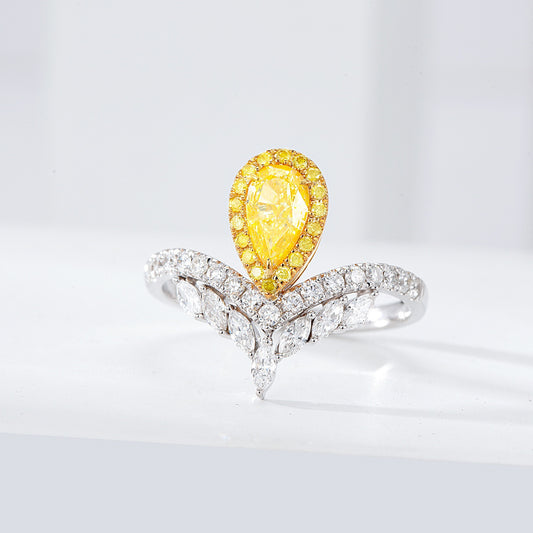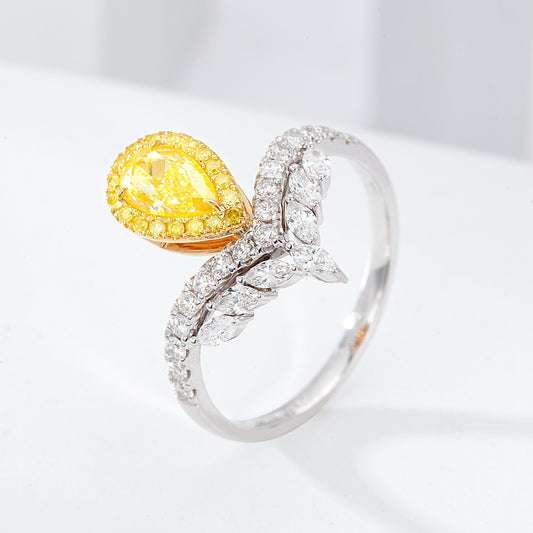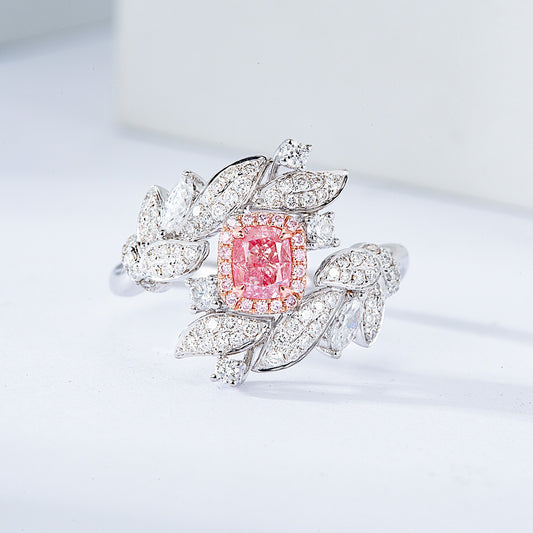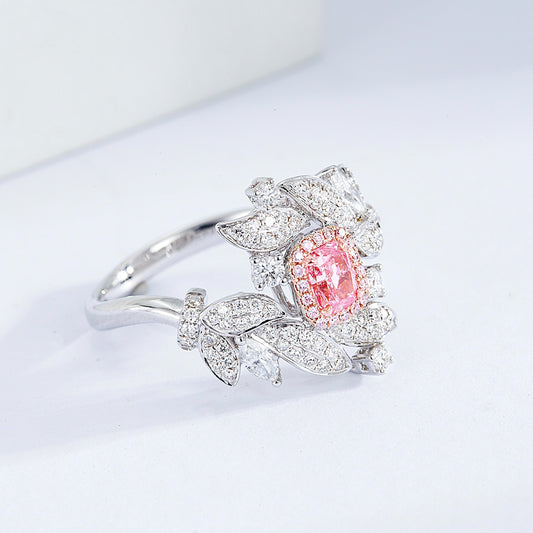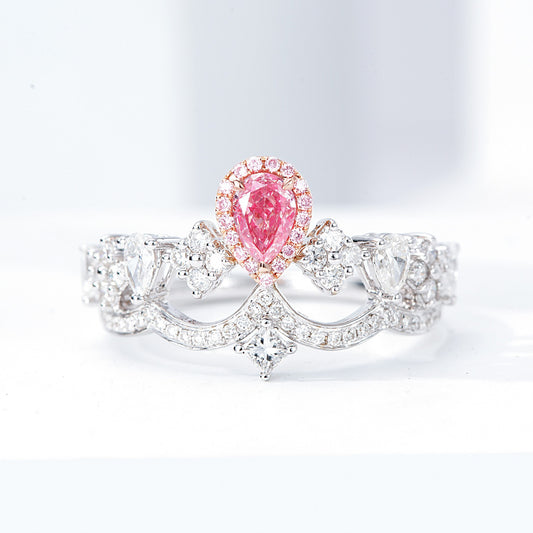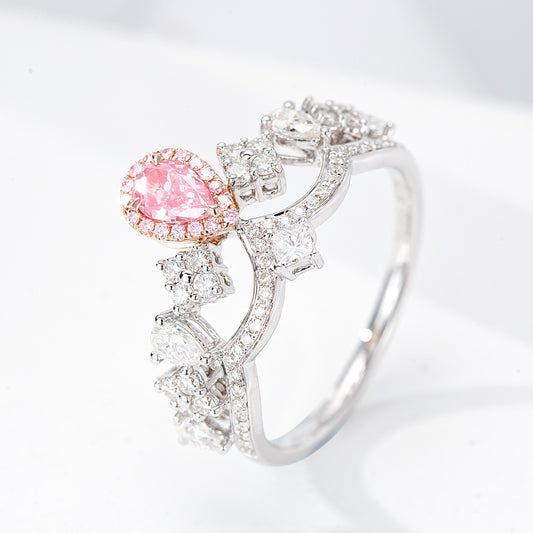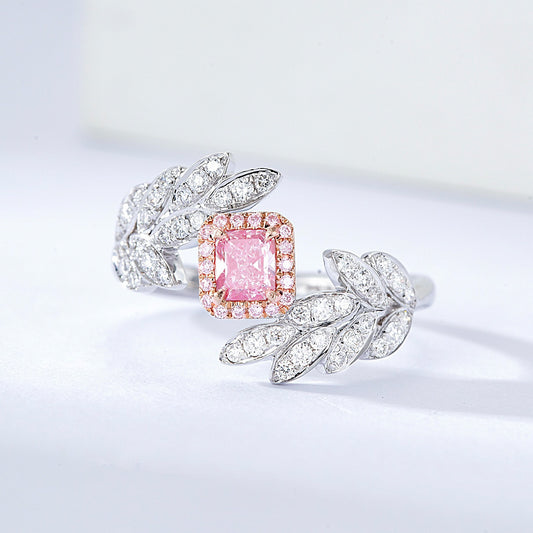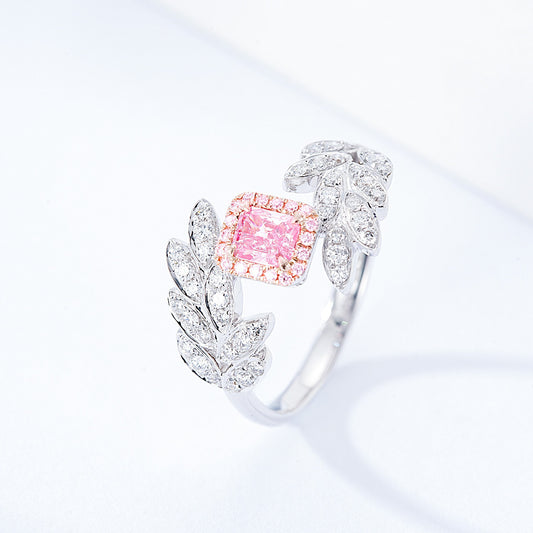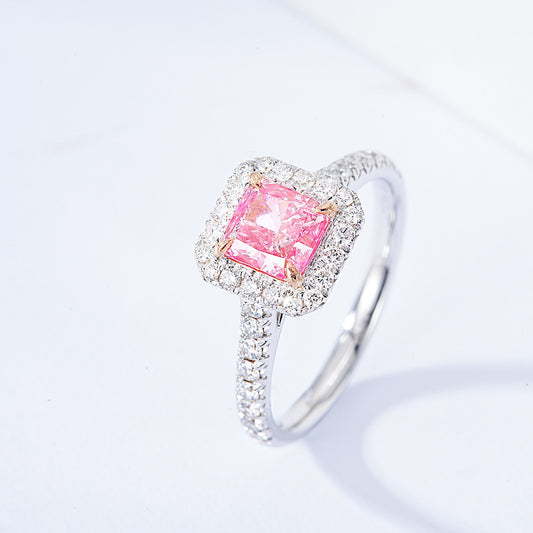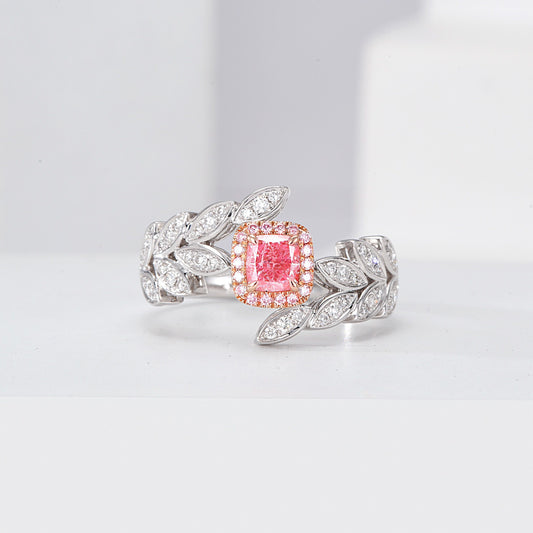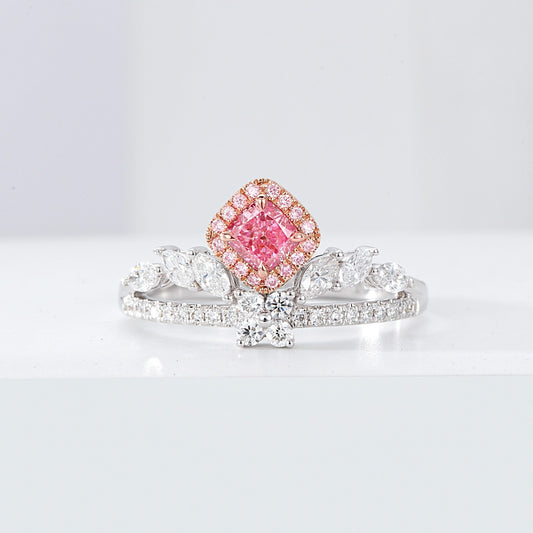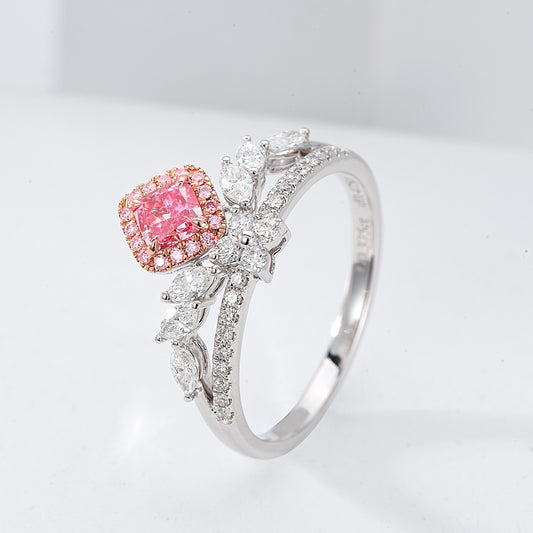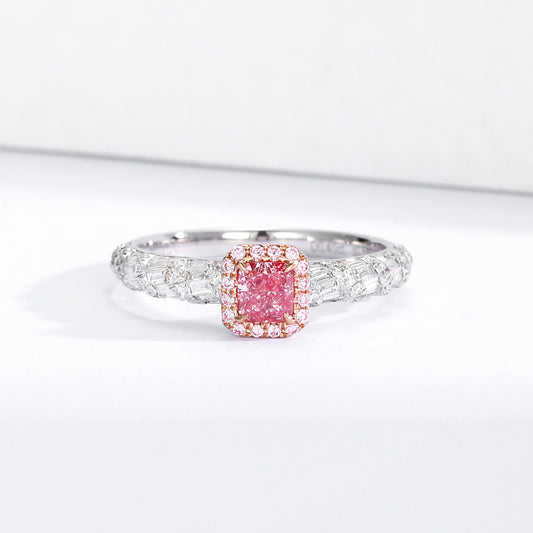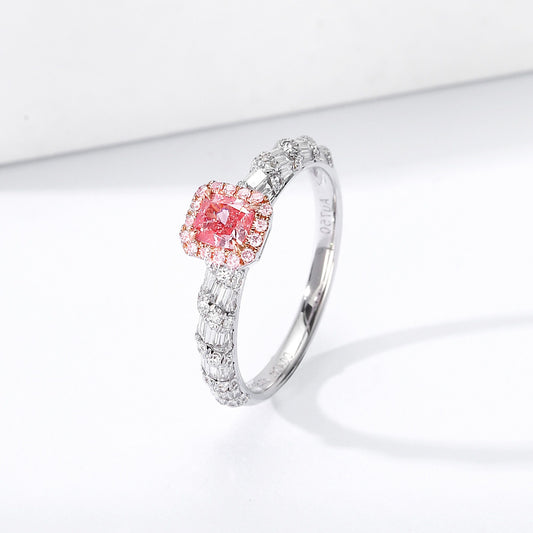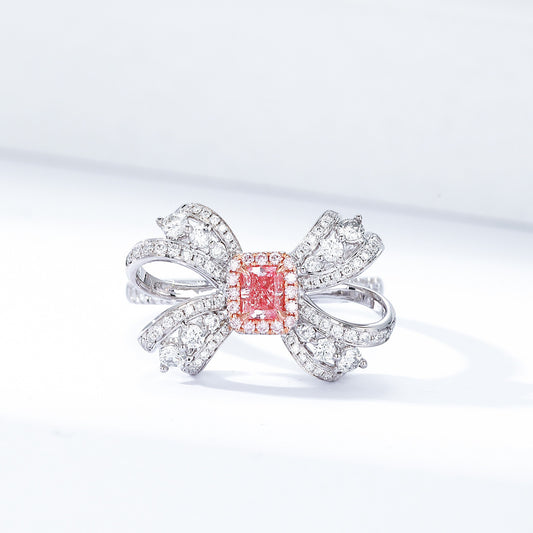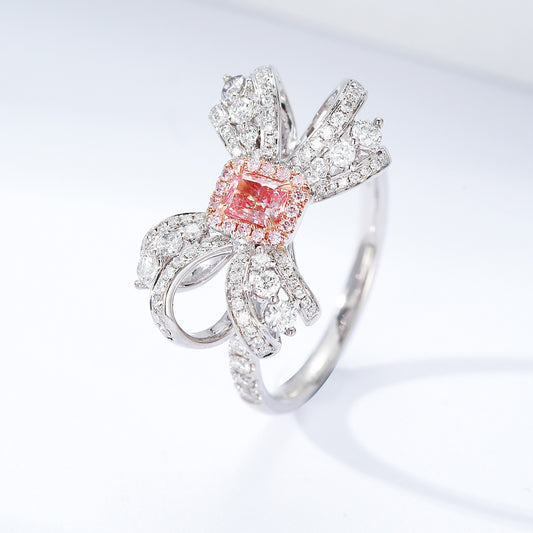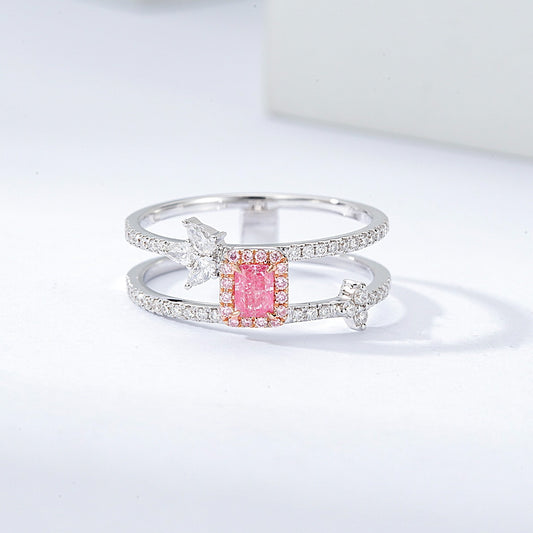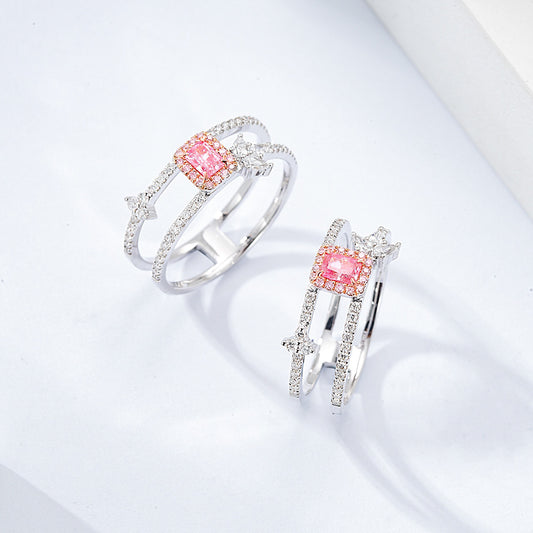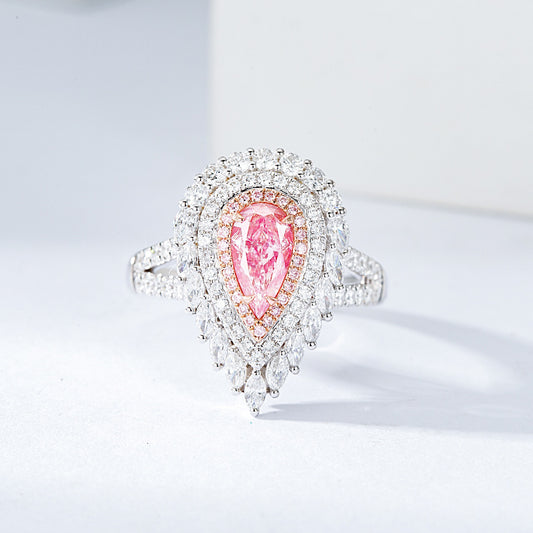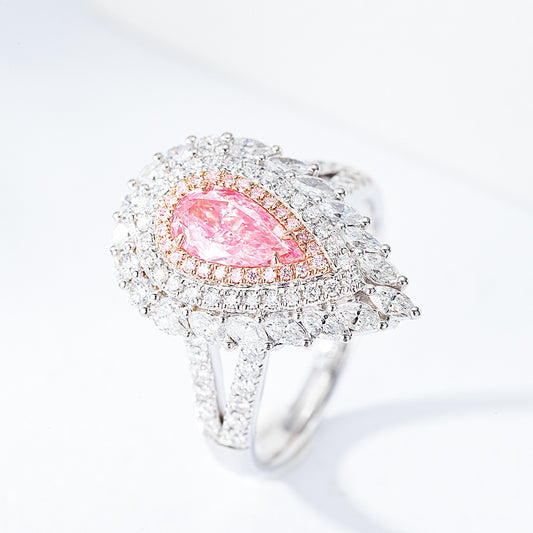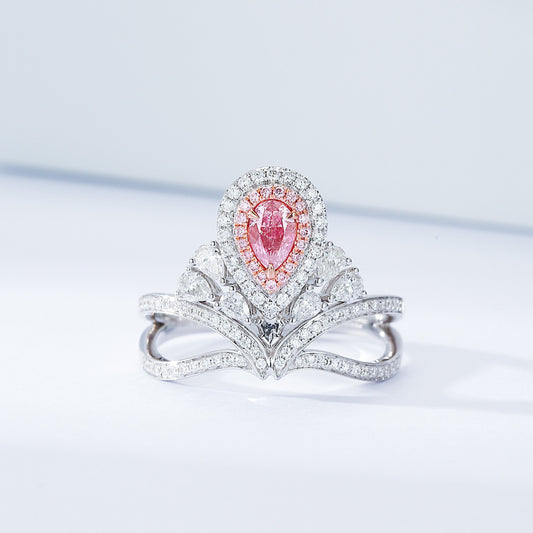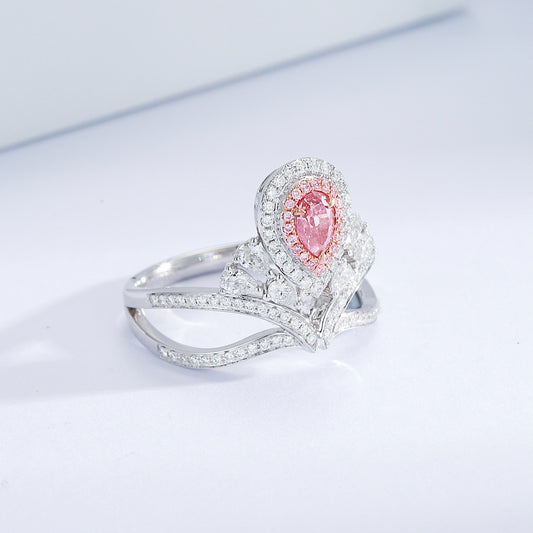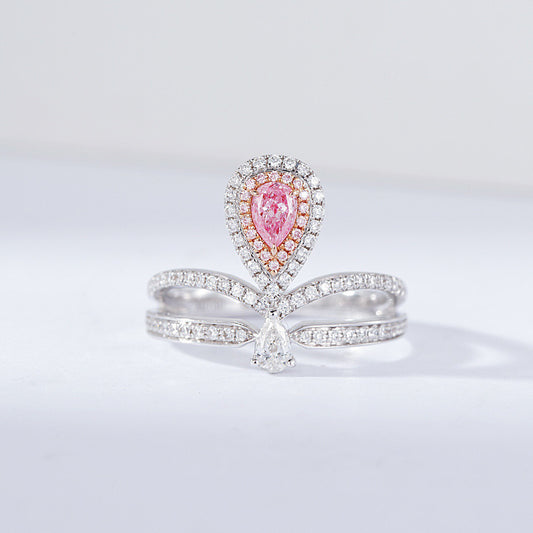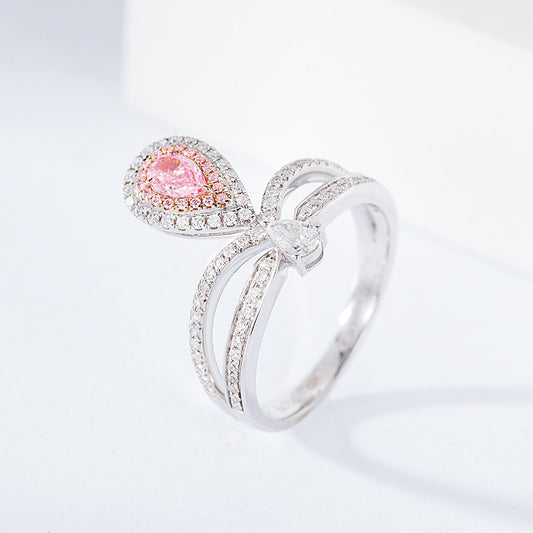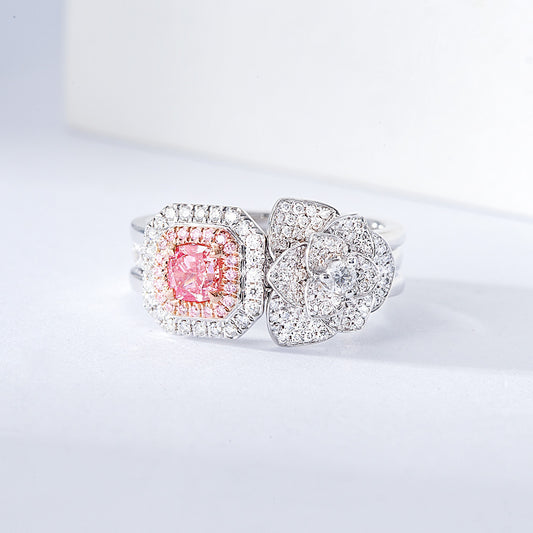-
Heart Shaped Yellow Diamond Ring with Bow Design
The perfect and exquisite, bow-shaped diamond engagement vividly captures what this photograph is about. The ruffled ribbon casing is encrusted with further one point of diamond white and yellow, which contribute additional richness and brightness to the ornament. The ethereal col ornation with rainbow yellow pavé seduces with the imaginary creations, astonishing outlines of the ring. Displayed here is an exquisite Icon pear shape yellow and pavé white diamond engagement ring with a total approximate diamond weight of 2.52 carats.- From $4,970.00
- From $4,970.00
- Unit price
- per
-
Pear Shaped Yellow Diamond Double Halo Engagement Ring with Pavé Band
A pear shape a yellow diamond displaying the most elegant of hues is the centrepiece in our white gold engagement ring. The pear shape yellow diamond center stone is encircled by a gleaming halo of stones, which extends to the gallery beneath and around the band, creating a scintillating silhouette from every angle. A refined diamond and white gold band with a total approximate weight of 1.79 carats.- From $2,450.00
- From $2,450.00
- Unit price
- per
-
Cushion Cut Yellow Diamond Double Halo Engagement Ring with Split Shank
This exclusive engagement ring features a stunning 1-carat cushion-cut yellow diamond as its centrepiece, surrounded by two concentric halos of sparkling white diamonds. The delicate diamond-encrusted split band further enhances the accessibility and elegance of this exquisite design. The ring boasts a total weight of 1.39 carats, with the certified 1.00-carat yellow diamond taking centre stage in a charming, elegant setting.- From $2,790.00
- From $2,790.00
- Unit price
- per
-
Cushion Cut Yellow Diamond Double Halo Engagement Ring with Pavé Accents
A cushion cut yellow diamond displaying the most delicate of hues is the breathtaking centrepiece in our yellow and white gold engagement ring. With its 1.5-carat cushion cushion cut makes an exquisitely statement, encircled by a halo of white diamonds. The combination of the yellow diamond and the surrounding halo makes this engagement ring a timeless symbol of luxury and refined style. An enchanting halo engagement diamond ring with a total weight of approximately 2.52carats.- From $3,570.00
- From $3,570.00
- Unit price
- per
-
Cushion Cut Yellow Diamond Double Halo Engagement Ring with Pavé Band
The exquisitely feminine hue of a 1-carat cushion cut elegant yellow diamond with a cushion-cut tanzanite and a double row of round brilliant diamonds. Radiating pure joy, the bewitching design showcases our expertise in crafting yellow diamond jewels that capture the eye and the heart. The joyful engagement ring with a total weight of approximately 1.85 carats.- From $2,980.00
- From $2,980.00
- Unit price
- per
-
Oval Cut Yellow Diamond Double Halo Engagement Ring with Floral Marquise Diamond Accents
A classic diamond cut displaying colour and this entrancing oval yellow diamond is encircled by a glimmering halo of diamonds in our yellow and white gold engagement ring. This accentuates its unique beauty and positioned in a bespoke setting to enhance its uniformly bright and pure colour. The joyful engagement ring with a total weight of approximately 2.67 carats.- From $4,780.00
- From $4,780.00
- Unit price
- per
-
Pear-Shaped Yellow Diamond Halo Engagement Ring with V Shaped Diamond Band
The center of this elegant shaped diamond ring is round 0.6 carat yellow diamond and it is ringed with bright yellow diamonds to further make it more attractive. The stylish V shaper band is embellished with 0.57 carat marquises and round cut diamonds making it very pretty. The engagement diamond ring with a total weight of approximately 1.17 carats, showcasing a 0.60 carat pear diamond.- $3,250.00
- $3,250.00
- Unit price
- per
-
Cushion Cut Pink Diamond Nature Inspired Engagement Ring with Leaf Motif
This nature inspired ring has a center stone that is a-piece cut 0.4 carat pink diamond surrounded by pink diamonds that go perfectly with the pink diamond. The design of the unique band that emulates the soft curves of the leaves has about 0.68 carats of round and marquise diamonds set in. An expressive engagement diamond ring with a total weight of approximately 1.08 carats.- From $4,800.00
- From $4,800.00
- Unit price
- per
-
Pear Shaped Pink Diamond Crown Inspired Engagement Ring with Diamond Accents
The core of this captivating ring is a 0.3-carat pear-shaped pink diamond, simply surrounded by a heap of pink diamonds which brings out its vivaciousness. It has an elaborate design with 0.72 carats of white diamond adornments including pear-shaped, round shaped, and princess cut stones which make it look noble and classy. The band that is crescent-shaped appears to be having its own crown imprinted on it to added to the overall glow making it just right for someone looking for unusual statement rings with high-end specs. The unique design is enhanced by 1.02 carats of marquise-cut and round diamonds that gracefully surround each center stone, creating a dynamic and elegant piece.- From $3,990.00
- From $3,990.00
- Unit price
- per
-
Cushion Cut Pink Diamond Nature Inspired Engagement Ring with Leaf Design
The center stone of this nature-inspired ring is a 0.3 carat cushion cut pink diamond, which is surrounded by a delicate halo of pink diamonds that contribute to its vibrancy. This open band style features 0.39 carat of round-cut diamonds displaying an elegant leaf pattern resulting in an organic appearance. The contrast between vivid pink centerpiece and intricately arranged round diamonds bestows on this ring sophistication and timelessness; it's meant for anyone who loves both elegance and artistry combined. An enchanting Double Wing Silhouette pave diamond ring with a total weight of approximately 0.69 carat.- From $3,550.00
- From $3,550.00
- Unit price
- per
-
Radiant Cut Pink Diamond Halo Engagement Ring With Pavé Band
Set in this exquisite band is a 1 carat radiant cut pink diamond encircled by a halo of white diamonds that increase its brilliance. The ring's overall sheen and luxury are further enhanced by the band which is pavé-set and has an added 0.48 carats of diamonds. It is a classic and sophisticated design as the pink center stone along with the halo and pavé band thus making it suitable for either engagement or any other event. The Radiant Cut Pink Diamond Halo Engagement Ring with a total weight of approximately 1.48 carats.- From $3,570.00
- From $3,570.00
- Unit price
- per
-
Cushion Cut Pink Diamond Engagement Ring with Olive Branch Design
This delicate ring features a 0.5 carat cushion cut pink diamond which is its focal point while pink diamond halos bring out its vivid hue even more. The open band has 0.25 carat of round diamonds arranged in an intricate olive branch design symbolizing peace; it creates balance between heaviness on top (in the form of the gem) and lightness at bottom (the branches). Because it represents love, life, or other abstract notions such as freedom etc., they are often chosen by women who want something different from what everyone wears. An enchanting live branch design marquise and cushion cut pink diamond ring with a total approximate weight of 0.75 carat.- From $4,390.00
- From $4,390.00
- Unit price
- per
-
Cushion Cut Pink Diamond Crown Engagement Ring in 18K White Gold
A diamond of a 0.35 carat is mounted on this engagement ring in a crown design. It features an 18K white gold band adorned with round cut diamonds and pear-shaped side stones whose total weight adds up to approximately 0.47 carat. An enchanting Cushion Cut Pink Diamond Crown ring with a total weight of approximately 0.82 carat.- From $4,180.00
- From $4,180.00
- Unit price
- per
-
Cushion Cut Pink Diamond Engagement Ring with Baguette and Round Diamond Accents
The centerpiece is composed of a cushion-shaped pink diamond weighing 0.40 carats while its vibrant color is complemented by finely set pink diamonds that surround it. And to make sure that the design has some depth as well as sophistication, the band is embraced with a mix of emerald-cut and round diamonds having an approximate weight of about 0.59 carats in totality. The versatile pink center stone blended with rectangular emeralds and circular diamonds creates a sumptuous item that thrives in any social gathering. The elegant Cushion Cut Pink Diamond ring with round diamond band with a total weight of approximately 0.99 carat.- From $4,090.00
- From $4,090.00
- Unit price
- per
-
Radiant Cut Pink Diamond Ring with Bow Design in 18K Gold
This beautiful ring has a 0.25 carat cushion cut pink diamond in the center of it which is surrounded by a thin halo that makes the color even more vivid. On top of that, there are some 0.62 carats worth of glittering diamonds set on the bow inspired part giving this piece an overall sense of sophistication and grace. The curling details and line of this design manage to mix together playfulness as well as refinement making it suitable for people who like old-fashioned allure along with new century art work. Radiant Cut Pink Diamond Ring with bowknot design in 18K gold with a total weight of 1.40 carats, showcasing a certified 0.25 carat round diamond with natural diamond.- From $3,350.00
- From $3,350.00
- Unit price
- per
-
Radiant Cut Pink Diamond Double Band Ring with Arrow Design
At the core of this lovely ring is a 0.15 carat radiant cut pink diamond encircled by a dainty pink halo. It is set with 0.35 carats of round and marquise shaped diamonds on the dual bands arranged as arrows. With its playful yet graceful design showing contrast shapes and colors it is perfect for those individuals who fancy an elegant and stylish statement in jewelry. A charming Radiant Cut Pink Diamond Ring with weight of 0.49 carats.- $2,140.00
- $2,140.00
- Unit price
- per
-
Pear Shaped Pink Diamond Ring with Double Halo and Marquise Accents
Showcasing an astonishing pear-shaped pink diamond at its centre, this stunning ring is encapsulated beautifully within pink and white diamonds in a dual halo. A number of marquise-shaped stones have been included in the design which add to its intricate layers making it appear luxurious and imperial as well. The vibrant pink gem at the heart of all concerns itself with delicate halo and overlapping diamond ornaments cascade; hence it is the perfect ring for those who want both refinement and daring designs at the same time. An elegant Pear-Shaped Pink Diamond Ring with a total weight of approximately 1.85 carats, featuring 0.70 carat natural diamonds.- From $8,660.00
- From $8,660.00
- Unit price
- per
-
Pear Shaped Pink Diamond Ring with Crown Designer 18K White Gold
The graceful curves and sparkling diamond accents mean this stylish ring brings out a royal regal look due to its intricate design that perfectly combines a vivid pink center stone with an elegant structure pattern for those who love elegance and dignity in designs. A charming Pear Cut Pink Diamond Ring with a total weight of 0.89 carat, showcasing a 0.30 carat pear shape diamond and pavé diamond band.- From $4,400.00
- From $4,400.00
- Unit price
- per
-
Pear-Shaped Pink Diamond Crown Design Ring with Double Halo
The graceful curves and sparkling diamond accents mean this stylish ring brings out a royal regal look due to its intricate design that perfectly combines a vivid pink center stone with an elegant structure pattern for those who love elegance and dignity in designs. An elegant Pear Shaped Pink Diamond Crown Design Ring with a total weight of approximately 0.65 carat, featuring 0.25 carat pear shape diamonds.- From $4,450.00
- From $4,450.00
- Unit price
- per
-
Convertible Cushion Cut Pink Diamond and Flower Design Ring Set
This is a stretch in a ring range with a special design that may be put on at once as a pronouncement part or used separately for a simpler style. One ring shows off a pink diamond which is cushion cut and is at the middle pointed out by a double halo of pink and white diamonds. It is evident in its whole look that it carries with itself an aura of grace and elegance about it making one think twice before wanting to take off this magnificent piece from their fingers never mind how tempting they might be. An elegant Convertible Cushion Cut Pink Diamond and Flower Design Ring Set with a total weight of approximately 0.97 carat, featuring 0.40 carat center diamonds.- From $4,970.00
- From $4,970.00
- Unit price
- per
White Gold Engagement Rings
White gold Shop All Engagement Rings offer a timeless and elegant choice, combining the classic beauty of white gold with the dazzling brilliance of diamonds. Halo settings are particularly popular, featuring a central diamond surrounded by a circle of smaller stones that enhance its sparkle and create a captivating visual effect. This style not only highlights the main diamond but also adds a touch of vintage charm and sophistication to the ring.
For those who appreciate a touch of tradition with a modern twist, three-stone white gold engagement rings provide a meaningful and stylish option. This design showcases three diamonds—typically representing the past, present, and future of your relationship—set in a sleek white gold band. Additionally, pavé settings, with their continuous line of diamonds adorning the band, add extra sparkle and elegance, making the ring a stunning centerpiece that beautifully complements the brilliance of the central stone.
Explore Related Pages
Shop All Engagement Rings
Shop Yellow Gold Engagement Rings
Shop 1 Carat Engagement Rings
Shop 2 Carat Engagement Rings
Shop Yellow Diamond Engagement Rings
Shop Pink Diamond Engagement Rings
Shop Green Diamond Engagement Rings
Shop Luxe Engagement Rings
Shop Nature Inspired Engagement Rings
Shop Vintage Engagement Rings
Learn about Engagement Ring Settings and Styles
FAQs about White Gold Engagement Rings
When it comes to fancy colored diamonds, the choice between white or yellow gold can significantly influence the appearance and impact of the stone:
- White Gold Engagement Rings: White gold settings often highlight the vibrancy and contrast of fancy colored diamonds. The cool, neutral tone of white gold can create a striking contrast that emphasizes the unique color of the diamond, whether it’s a vivid pink, blue, or green. This metal is particularly effective in making the color of the diamond stand out and appear more intense, offering a modern and sophisticated look.
- Yellow Gold Engagement Rings: Yellow gold settings can enhance the warmth and richness of certain fancy colored diamonds, especially those with warm tones like yellow, orange, or champagne diamonds. The warm hue of yellow gold complements and amplifies the natural color of these diamonds, creating a harmonious and luxurious appearance. Yellow gold is often chosen for its classic, timeless appeal, which adds an extra layer of elegance to the overall design.
Ultimately, the choice between white or yellow gold for a fancy colored diamond depends on the desired aesthetic and how you want the diamond's color to be showcased. Both metals offer distinct advantages, allowing you to customize the ring to reflect your personal style and the unique beauty of the diamond.
Yes, white gold is a popular and elegant choice for engagement rings. It offers a timeless look that enhances the brilliance of diamonds and gemstones.
White gold offers several advantages, making it a popular choice for engagement rings and other fine jewelry:
Elegant Appearance: White gold has a sleek, modern look that complements the brilliance of diamonds and other gemstones. Its neutral tone enhances the sparkle and color of the stones, making them appear more vibrant and radiant.
Versatility: White gold pairs well with a variety of gemstones and styles, from classic solitaires to intricate designs like halo or pavég settings. Its timeless appeal suits both contemporary and vintage-inspired designs, making it a versatile choice for different tastes.
Durability: White gold is more durable than pure gold (24K) because it is alloyed with stronger metals like nickel, palladium, or silver. This added strength makes it resistant to scratching and bending, making it a practical choice for everyday wear.
Affordability: White gold is generally more affordable than platinum, offering a similar white, lustrous appearance at a lower price point. This makes it an attractive option for those who want the look of platinum without the higher cost.
Hypoallergenic Options: For those with sensitive skin, white gold can be alloyed with hypoallergenic metals like palladium, reducing the risk of allergic reactions compared to other metal alloys that may contain nickel.
Rhodium Plating: White gold is typically coated with rhodium, a platinum-group metal, which enhances its shine and provides a brilliant, reflective surface. This plating also adds an extra layer of protection, making the jewelry more resistant to tarnish and wear.
Customizability: White gold can be easily crafted into various designs, allowing for a wide range of customization options. Whether you prefer a minimalist design or a more elaborate setting, white gold can accommodate different styles.
Overall, white gold is valued for its combination of beauty, strength, and versatility, making it a popular and enduring choice for engagement rings and other fine jewelry.
Choosing between 14K and 18K white gold depends on your priorities regarding durability, color, price, and personal preference:
Color:
- 14K White Gold: Has a slightly cooler, whiter appearance due to the higher percentage of alloy metals, which can enhance the brightness of the metal.
- 18K White Gold: Has a richer, warmer tone because of the higher gold content, which can give it a slightly more luxurious appearance. However, both 14K and 18K white gold are usually rhodium-plated, which gives them a similar bright white finish.
Price:
- 14K White Gold: Less expensive than 18K white gold due to the lower gold content. It’s a cost-effective option that still offers a beautiful and durable metal for your jewelry.
- 18K White Gold: More expensive because it contains more pure gold. It’s often preferred by those who want a higher gold content in their jewelry and are willing to pay a premium for it.
Hypoallergenic Properties:
- 14K White Gold: Contains a higher percentage of alloy metals, which could potentially cause allergic reactions in some people, especially if the alloy includes nickel.
- 18K White Gold: Contains less alloy metal, making it slightly less likely to cause allergic reactions, particularly if it’s alloyed with hypoallergenic metals like palladium.
Summary:
- Choose 14K white gold if you prioritize durability, affordability, and a cooler white appearance.
- Choose 18K white gold if you prefer a higher gold content, a slightly warmer tone, and don’t mind paying a bit more for luxury and purity.
Both options are beautiful and suitable for fine jewelry, so your decision should be based on what factors matter most to you.
- Choosing a selection results in a full page refresh.
